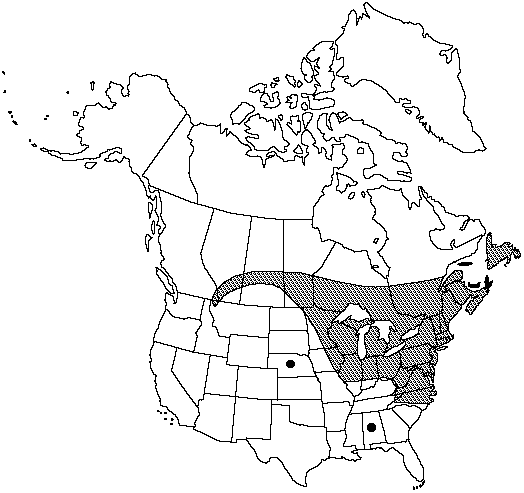Difference between revisions of "Dryopteris cristata"
Manual 631. 1848.
FNA>Volume Importer |
imported>Volume Importer |
||
| (One intermediate revision by the same user not shown) | |||
| Line 8: | Line 8: | ||
}} | }} | ||
|common_names=Crested wood fern;dryoptère à crêtes | |common_names=Crested wood fern;dryoptère à crêtes | ||
| + | |special_status={{Treatment/ID/Special_status | ||
| + | |code=F | ||
| + | |label=Illustrated | ||
| + | }} | ||
|basionyms={{Treatment/ID/Basionym | |basionyms={{Treatment/ID/Basionym | ||
|name=Polypodium cristatum | |name=Polypodium cristatum | ||
| Line 28: | Line 32: | ||
|habitat=Swamps, swampy woods, or open shrubby wetlands | |habitat=Swamps, swampy woods, or open shrubby wetlands | ||
|elevation=0–1200 m | |elevation=0–1200 m | ||
| − | |distribution=Alta.;B.C.;Man.;N.B.;Nfld.;N.S.;Ont.;P.E.I.;Que.;Sask.;Ala.;Conn.;Del.;Ill.;Ind.;Iowa;Maine;Md.;Mass.;Mich.;Minn.;Mont.;Nebr.;N.H.;N.J.;N.Y.;N.C.;N.Dak.;Ohio;Pa.;R.I.;Tenn.;Vt.;Va.;W.Va.;Wis.;Europe. | + | |distribution=Alta.;B.C.;Man.;N.B.;Nfld. and Labr. (Nfld.);N.S.;Ont.;P.E.I.;Que.;Sask.;Ala.;Conn.;Del.;Ill.;Ind.;Iowa;Maine;Md.;Mass.;Mich.;Minn.;Mont.;Nebr.;N.H.;N.J.;N.Y.;N.C.;N.Dak.;Ohio;Pa.;R.I.;Tenn.;Vt.;Va.;W.Va.;Wis.;Europe. |
|discussion=<p><i>Dryopteris cristata</i> is believed to be an allotetraploid derived from <i>D. ludoviciana</i> and an unknown diploid called " D. semicristata " by W. H. Wagner Jr. (1971). This ancestral taxon could have been either North American or Eurasian and may have become extinct during the last glaciation (T. J. Carlson and W. H. Wagner Jr. 1982). <i>Dryopteris cristata</i> hybridizes with five species; these hybrids can be identified by the narrow blades and deltate proximal pinnae.</p> | |discussion=<p><i>Dryopteris cristata</i> is believed to be an allotetraploid derived from <i>D. ludoviciana</i> and an unknown diploid called " D. semicristata " by W. H. Wagner Jr. (1971). This ancestral taxon could have been either North American or Eurasian and may have become extinct during the last glaciation (T. J. Carlson and W. H. Wagner Jr. 1982). <i>Dryopteris cristata</i> hybridizes with five species; these hybrids can be identified by the narrow blades and deltate proximal pinnae.</p> | ||
|tables= | |tables= | ||
| Line 46: | Line 50: | ||
|habitat=Swamps, swampy woods, or open shrubby wetlands | |habitat=Swamps, swampy woods, or open shrubby wetlands | ||
|elevation=0–1200 m | |elevation=0–1200 m | ||
| − | |distribution=Alta.;B.C.;Man.;N.B.;Nfld.;N.S.;Ont.;P.E.I.;Que.;Sask.;Ala.;Conn.;Del.;Ill.;Ind.;Iowa;Maine;Md.;Mass.;Mich.;Minn.;Mont.;Nebr.;N.H.;N.J.;N.Y.;N.C.;N.Dak.;Ohio;Pa.;R.I.;Tenn.;Vt.;Va.;W.Va.;Wis.;Europe. | + | |distribution=Alta.;B.C.;Man.;N.B.;Nfld. and Labr. (Nfld.);N.S.;Ont.;P.E.I.;Que.;Sask.;Ala.;Conn.;Del.;Ill.;Ind.;Iowa;Maine;Md.;Mass.;Mich.;Minn.;Mont.;Nebr.;N.H.;N.J.;N.Y.;N.C.;N.Dak.;Ohio;Pa.;R.I.;Tenn.;Vt.;Va.;W.Va.;Wis.;Europe. |
|reference=None | |reference=None | ||
|publication title=Manual | |publication title=Manual | ||
|publication year=1848 | |publication year=1848 | ||
| − | |special status= | + | |special status=Illustrated |
| − | |source xml=https:// | + | |source xml=https://bitbucket.org/aafc-mbb/fna-data-curation/src/2e0870ddd59836b60bcf96646a41e87ea5a5943a/coarse_grained_fna_xml/V2/V2_490.xml |
|genus=Dryopteris | |genus=Dryopteris | ||
|species=Dryopteris cristata | |species=Dryopteris cristata | ||
Latest revision as of 21:23, 5 November 2020
Leaves dimorphic, 35–70 × 8–12 cm; fertile leaves dying back in winter; sterile leaves several, small, green through winter, forming "rosette." Petiole 1/4–1/3 length of leaf, scaly at least at base; scales scattered, tan. Blade green, narrowly lanceolate or with parallel sides, pinnate-pinnatifid, not glandular. Pinnae of fertile leaves twisted out of plane of blade and perpendicular to it, deltate; basal pinnae deltate, somewhat reduced, basal pinnules longer than adjacent pinnules, basal basiscopic pinnule and basal acroscopic pinnule equal; pinnule margins distantly serrate, with spiny teeth. Sori midway between midvein and margin of segments. Indusia lacking glands. 2n = 164.
Habitat: Swamps, swampy woods, or open shrubby wetlands
Elevation: 0–1200 m
Distribution

Alta., B.C., Man., N.B., Nfld. and Labr. (Nfld.), N.S., Ont., P.E.I., Que., Sask., Ala., Conn., Del., Ill., Ind., Iowa, Maine, Md., Mass., Mich., Minn., Mont., Nebr., N.H., N.J., N.Y., N.C., N.Dak., Ohio, Pa., R.I., Tenn., Vt., Va., W.Va., Wis., Europe.
Discussion
Dryopteris cristata is believed to be an allotetraploid derived from D. ludoviciana and an unknown diploid called " D. semicristata " by W. H. Wagner Jr. (1971). This ancestral taxon could have been either North American or Eurasian and may have become extinct during the last glaciation (T. J. Carlson and W. H. Wagner Jr. 1982). Dryopteris cristata hybridizes with five species; these hybrids can be identified by the narrow blades and deltate proximal pinnae.
Selected References
None.
